The University of California Davis Center for Citizen and Community Science worked with the staff of Public Lab to create a Logic Model that we could use in evaluating our impact. Here it is, both the direct link, and as an image:
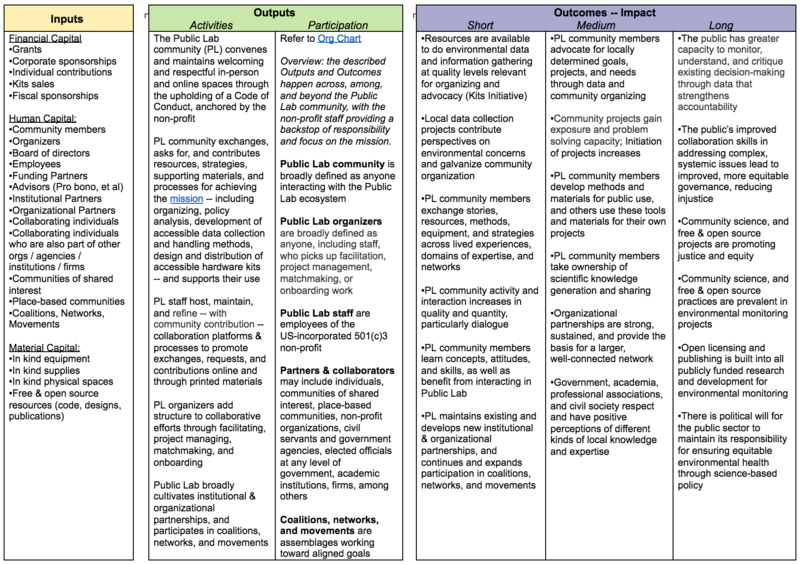
Let's take closer look
Clearly, there's a lot of densely packed information in here. Let's explore column by column; I created a graphic to illustrate each column followed by plain text:
Inputs
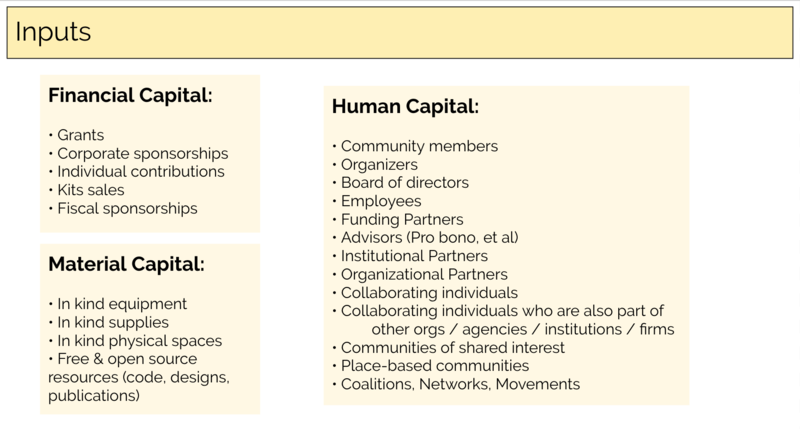 Financial Capital
Financial Capital
- Grants
- Corporate sponsorships
- Individual contributions
- Kits sales
- Fiscal sponsorships
Human Capital:
- Community members
- Organizers
- Board of directors
- Employees
- Funding Partners
- Advisors (Pro bono, et al)
- Institutional Partners
- Organizational Partners
- Collaborating individuals •Collaborating individuals who are also part of other orgs / agencies / institutions / firms
- Communities of shared interest
- Place-based communities
- Coalitions, Networks, Movements
Material Capital:
- In kind equipment
- In kind supplies
- In kind physical spaces
- Free & open source resources (code, designs, publications)
Outputs - activities
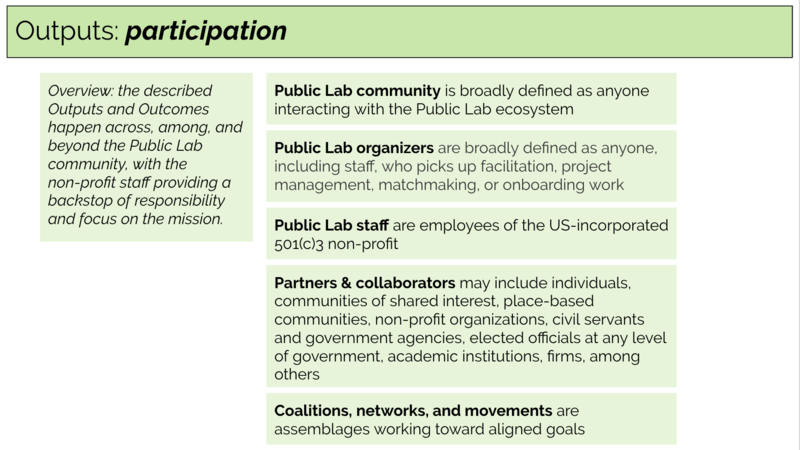
The Public Lab community (PL) convenes and maintains welcoming and respectful in-person and online spaces through the upholding of a Code of Conduct, anchored by the non-profit
PL community exchanges, asks for, and contributes resources, strategies, supporting materials, and processes for achieving the mission -- including organizing, policy analysis, development of accessible data collection and handling methods, design and distribution of accessible hardware kits -- and supports their use
PL staff host, maintain, and refine -- with community contribution -- collaboration platforms & processes to promote exchanges, requests, and contributions online and through printed materials
PL organizers add structure to collaborative efforts through facilitating, project managing, matchmaking, and onboarding
Public Lab broadly cultivates institutional & organizational partnerships, and participates in coalitions, networks, and movements
Outputs - participation
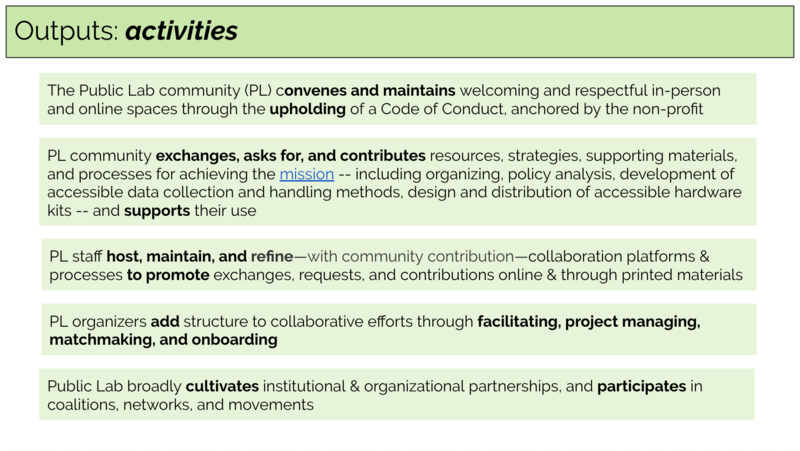
Overview: the described Outputs and Outcomes happen across, among, and beyond the Public Lab community, with the non-profit staff providing a backstop of responsibility and focus on the mission. Refer to Org Chart.
Public Lab community is broadly defined as anyone interacting with the Public Lab ecosystem
Public Lab organizers are broadly defined as anyone, including staff, who picks up facilitation, project management, matchmaking, or onboarding work
Public Lab staff are employees of the US-incorporated 501(c)3 non-profit
Partners & collaborators may include individuals, communities of shared interest, place-based communities, non-profit organizations, civil servants and government agencies, elected officials at any level of government, academic institutions, firms, among others
Coalitions, networks, and movements are assemblages working toward aligned goals
Outcomes - short term
These short-term outcomes are numbered for ease of reference, and the image contains abbreviated text to make these faster to comprehend by new readers:

1 - Resources are available to do environmental data and information gathering at quality levels relevant for organizing and advocacy (Kits Initiative)
2 - Local data collection projects contribute perspectives on environmental concerns and galvanize community organization
3 - PL community members exchange stories, resources, methods, equipment, and strategies across lived experiences, domains of expertise, and networks
4 - PL community activity and interaction increases in quality and quantity, particularly dialogue
5 - PL community members learn concepts, attitudes, and skills, as well as benefit from interacting in Public Lab
6 - PL maintains existing and develops new institutional & organizational partnerships, and continues and expands participation in coalitions, networks, and movements
Outcomes - medium term
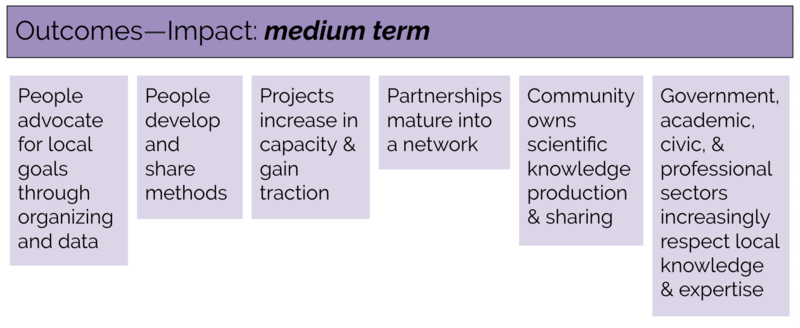
PL community members advocate for locally determined goals, projects, and needs through data and community organizing
Community projects gain exposure and problem solving capacity; Initiation of projects increases
PL community members develop methods and materials for public use, and others use these tools and materials for their own projects
PL community members take ownership of scientific knowledge generation and sharing
Organizational partnerships are strong, sustained, and provide the basis for a larger, well-connected network
Government, academia, professional associations, and civil society respect and have positive perceptions of different kinds of local knowledge and expertise
Outcomes - long term
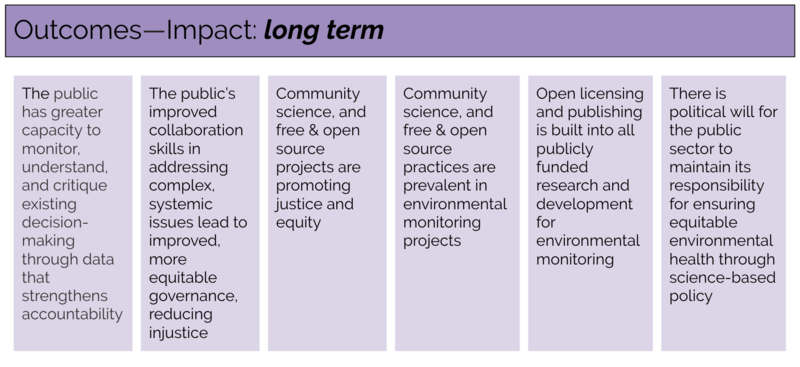
The public has greater capacity to monitor, understand, and critique existing decision-making through data that strengthens accountability
The public’s improved collaboration skills in addressing complex, systemic issues lead to improved, more equitable governance, reducing injustice
Community science, and free & open source projects are promoting justice and equity
Community science, and free & open source practices are prevalent in environmental monitoring projects
Open licensing and publishing is built into all publicly funded research and development for environmental monitoring
There is political will for the public sector to maintain its responsibility for ensuring equitable environmental health through science-based policy
0 Comments
Login to comment.